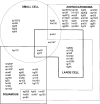Antinuclear antibodies as potential markers of lung cancer
- PMID: 10389924
- PMCID: PMC5635656
Antinuclear antibodies as potential markers of lung cancer
Abstract
There are multiple case reports of antinuclear antibodies (ANAs) in patients with malignancies, yet to date there has not been a systematic survey of ANAs in lung cancer. We have previously reported that autoantibodies to collagen antigens resembling those found in the connective tissue diseases are consistently detected in the sera from lung cancer patients. In this work, we looked for the presence of ANAs in the sera from these same patients. Sera from 64 patients with lung cancer and 64 subjects without a history of cancer were retrospectively tested for reactivity on immunoblots of nuclear extracts of HeLa, small cell carcinoma, squamous cell carcinoma, adenocarcinoma, large cell carcinoma of the lung, and of normal lung cells. Associations were sought between the reactivities on immunoblots and lung cancer cell type, diagnosis, and progression-free survival by the method of classification and regression trees (CARTs). Cross-validated CART analyses indicated that reactivities to certain bands in immunoblots are associated with different types of lung cancer. Some of these autoantibodies were associated with a prolonged survival without disease progression. Our data suggest that autoimmunity is often a prominent feature of lung cancer and that molecular characterization of these antigens may lead to the discovery of proteins with diagnostic and prognostic value.
Figures




 ) represents those with serum antibodies that did not bind the first four antigens but did bind one or more of the nuclear antigens am45, lg180, hg65, or am70. The presence of these antibodies predicted a survival without progression from 4 to 9 months. Those without serum antibodies binding any of these eight antigens (○) had a predicted survival without progression of <4 months. Testing for equality by log rank indicated a significant difference in survival distribution between the curves (P = 0.006). Antigen nomenclature is presented in Table 2.
) represents those with serum antibodies that did not bind the first four antigens but did bind one or more of the nuclear antigens am45, lg180, hg65, or am70. The presence of these antibodies predicted a survival without progression from 4 to 9 months. Those without serum antibodies binding any of these eight antigens (○) had a predicted survival without progression of <4 months. Testing for equality by log rank indicated a significant difference in survival distribution between the curves (P = 0.006). Antigen nomenclature is presented in Table 2.
References
-
- Abelev GI, Perova DS, Kheamkova NI, Posnikova ZA, Irlin IS. Production of embryonal α globulin by transplantable mouse hepatomas. Transplantation. 1963;1:174–180. - PubMed
-
- Day EA. The Immunochemistry of Cancer. Springfield, IL: C. C. Thomas; 1965.
-
- van der Bruggen P, Traversari C, Chomez P, Lurquin C, De Plaen E, Van den Eynde B, Knuth A, Boon T. A gene encoding an antigen recognized by cytolytic T lymphocytes on a human melanoma. Science (Washington DC) 1991;254:1643–1647. - PubMed
Publication types
MeSH terms
Substances
Grants and funding
LinkOut - more resources
Full Text Sources
Other Literature Sources
Medical
